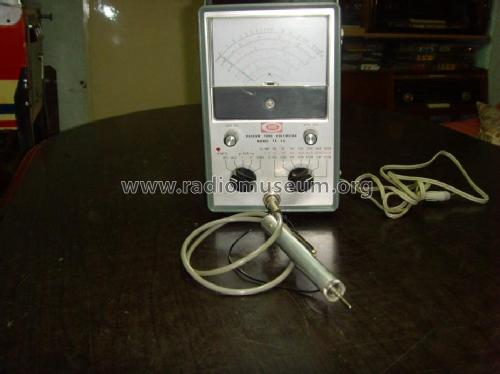RMSV-Meter TE-65
Tech Instruments Co. Ltd.; Tokyo
- Land
- Japan
- Hersteller / Marke
- Tech Instruments Co. Ltd.; Tokyo
- Jahr
- 1970–1972 ??
- Kategorie
- Service- oder Labor-Ausrüstung
- Radiomuseum.org ID
- 99728
Klicken Sie auf den Schaltplanausschnitt, um diesen kostenlos als Dokument anzufordern.
- Anzahl Röhren
- 2
- Wellenbereiche
- - ohne
- Betriebsart / Volt
- Wechselstromspeisung / 220-240 Volt
- Lautsprecher
- - - Kein Ausgang für Schallwiedergabe.
- Material
- Metallausführung
- von Radiomuseum.org
- Modell: RMSV-Meter TE-65 - Tech Instruments Co. Ltd.;
- Form
- Tischgerät, Hochformat (höher als quadratisch, schlicht, keine Kathedrale).
- Abmessungen (BHT)
- 140 x 215 x 150 mm / 5.5 x 8.5 x 5.9 inch
- Bemerkung
-
- Technische Daten:
- Innenwiderstand
- 11MΩ auf allen Bereichen
- Gleichspannungsmeßbereiche
- 1,5/5/15/50/150/500/1500V
- Wechselspannungsmeßbereiche
- Veff: 1,5/5/15/50/150/500/1500V
- Vss: 1,4/4/14/40/140/400/1400/4000V
- Widerstandsmeßbereiche
- 10/100/1k/10k/1M/10MΩ
- dB:
- -10 bis +65dB (0dB=1mW an 600Ω)
- Innenwiderstand
- Normalzubehör
- Gleichspannungsprüfspitze
- 2 Meßleitungen
- 1 Monozelle 1,5V
- 1 Bedienungsanleitung
- Sonderzubehör
- HV-Prüfspitze 30kV (28,50 DM)
- HF-Tastkopf 250MHz (26 DM)
Ähnlich oder baugleich mit Conrad CTR Röhrenvoltmeter HRV-240
The Eico 232 peak to peak VTVM seems to be an identical design supplied as a kit, thus had a detailed schematic.
Rated for up to 60 MHz without a special probe.
- Technische Daten:
- Nettogewicht
- 2.5 kg / 5 lb 8.1 oz (5.507 lb)
- Originalpreis
- 178.50 DM
- Literatur/Schema (1)
- -- Original-techn. papers. (Technik-Versand KG, Katalog Nr. 23, 1972)
- Autor
- Modellseite von Jos Lauth angelegt. Siehe bei "Änderungsvorschlag" für weitere Mitarbeit.
- Weitere Modelle
-
Hier finden Sie 18 Modelle, davon 17 mit Bildern und 9 mit Schaltbildern.
Alle gelisteten Radios usw. von Tech Instruments Co. Ltd.; Tokyo
Sammlungen
Das Modell RMSV-Meter befindet sich in den Sammlungen folgender Mitglieder.
Forumsbeiträge zum Modell: Tech Instruments Co.: RMSV-Meter TE-65
Threads: 1 | Posts: 4
I noticed that the Ohms range was erratic. Many or most of the schematics don't show it, but the 1.5V nominal D Cell (mono cell) is actually only connected when the left switch is at ohms.
Also the battery will run down quickly if there is a short on the probe leads on the low ohms range and on Ohms.
The resistance in series with the battery to test lead is low on low ranges:
9.7
90 + 9.7
900 + 90 + 9.7
9K + 900 + 90 + 9.7
Etc.
So if a voltage is on the test input then there can be considerable input current if the left switch is at Ohms (battery connected).
Naturally the 9.7, 90 and 900 resistors were a bit cooked. The 9.7 seems to have been 12 Ohms, it read 4 Ohms. Perhaps it had a parallel resistor. The 90 and 900 were both pairs of resistors.
So on the lowest range the battery supplies between 110mA and 160mA depend on if near exhausted or new. Obviously the other ranges progressively use about 1/10th each time.
As the valves take 600mA and the 6.3V winding is earthed at one side, it might be feasible to use a 1.25V to 1.6V regulator based on an LM317 (minimum is 1.2V approx.). However that would be easily damaged on the low resistance ranges by an in circuit voltage.
Perhaps the safer approach is simply to add a 250mA fuse to protect the resistors and battery on the low resistance ranges. An LM317 could have a reverse rectifier across it, but unlike a battery which can sink current long enough for the fuse to blow, there is nothing to sink current from the external source to blow the fuse.
Michael Watterson, 07.Jun.24










